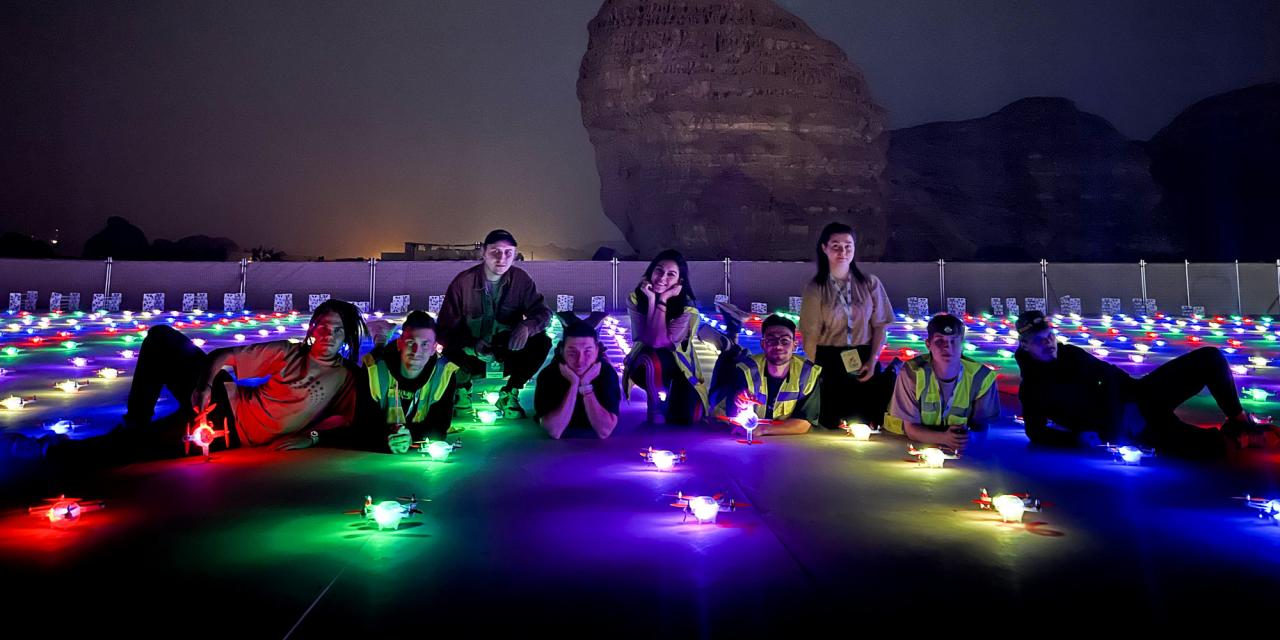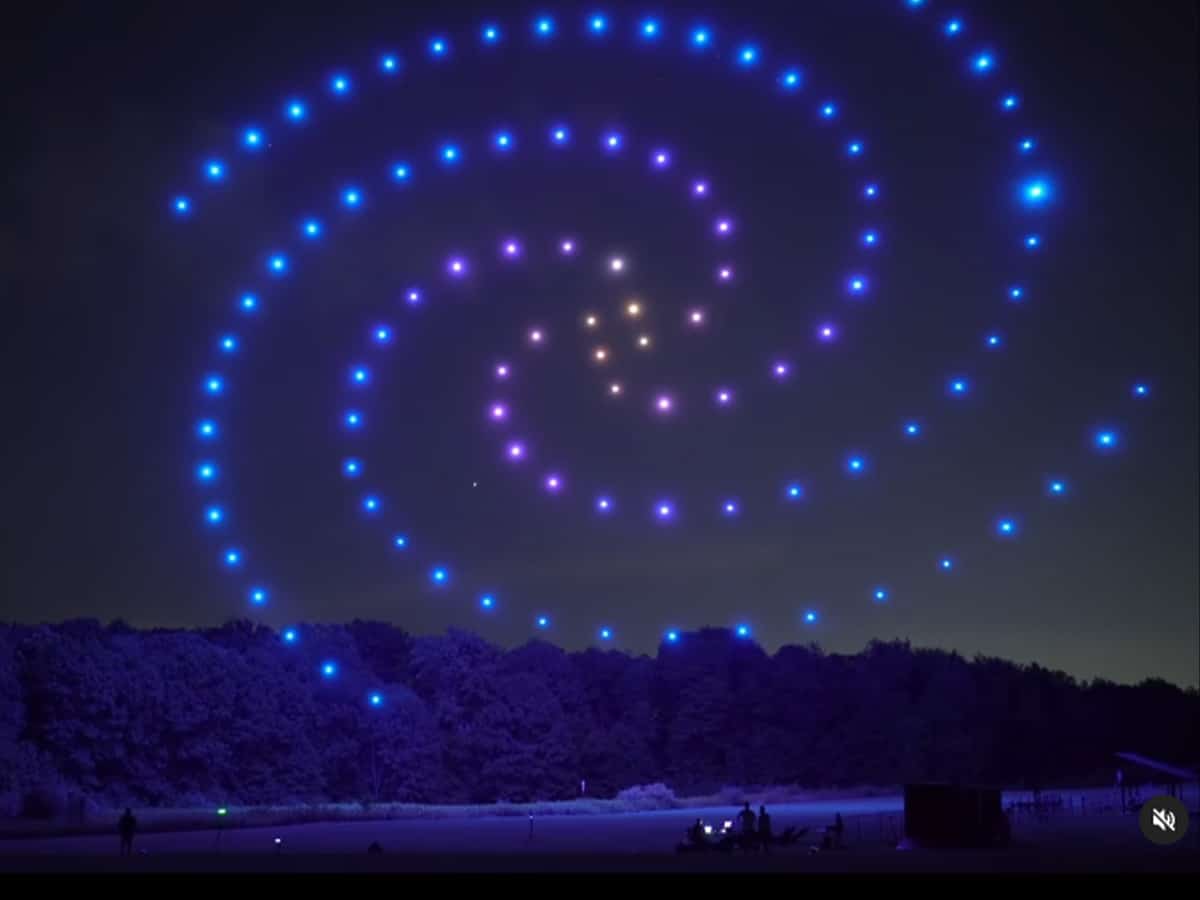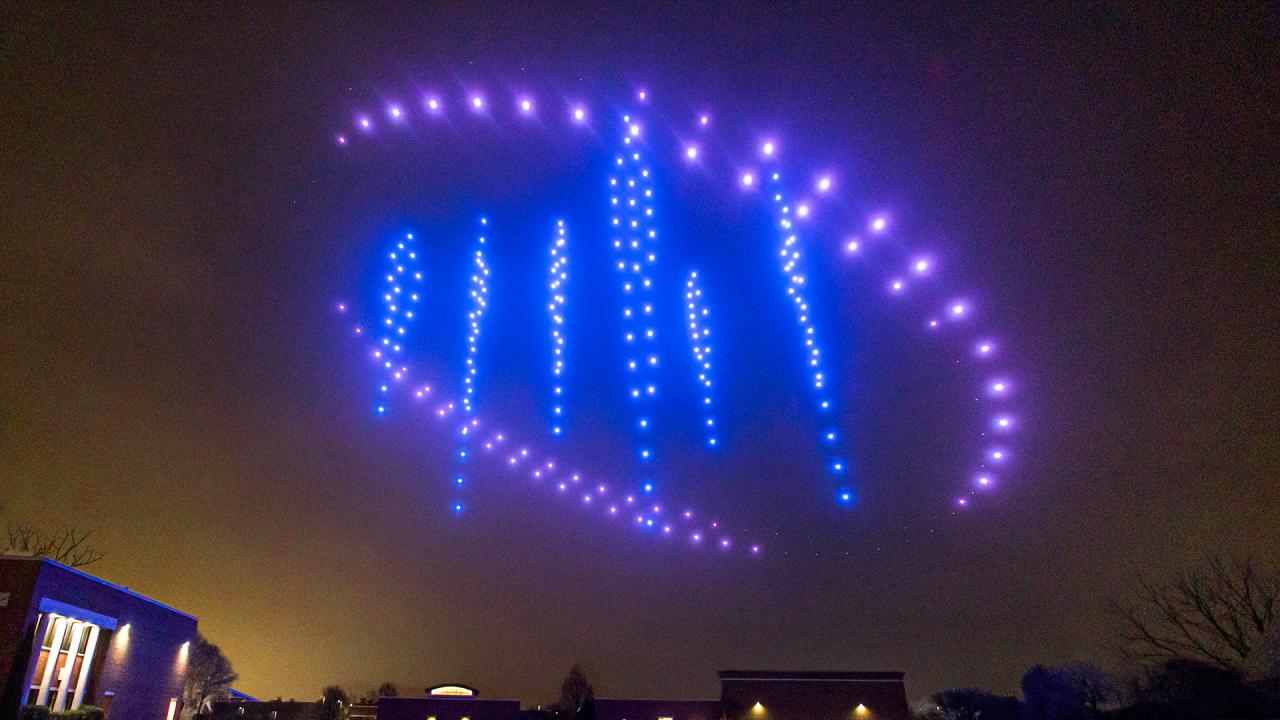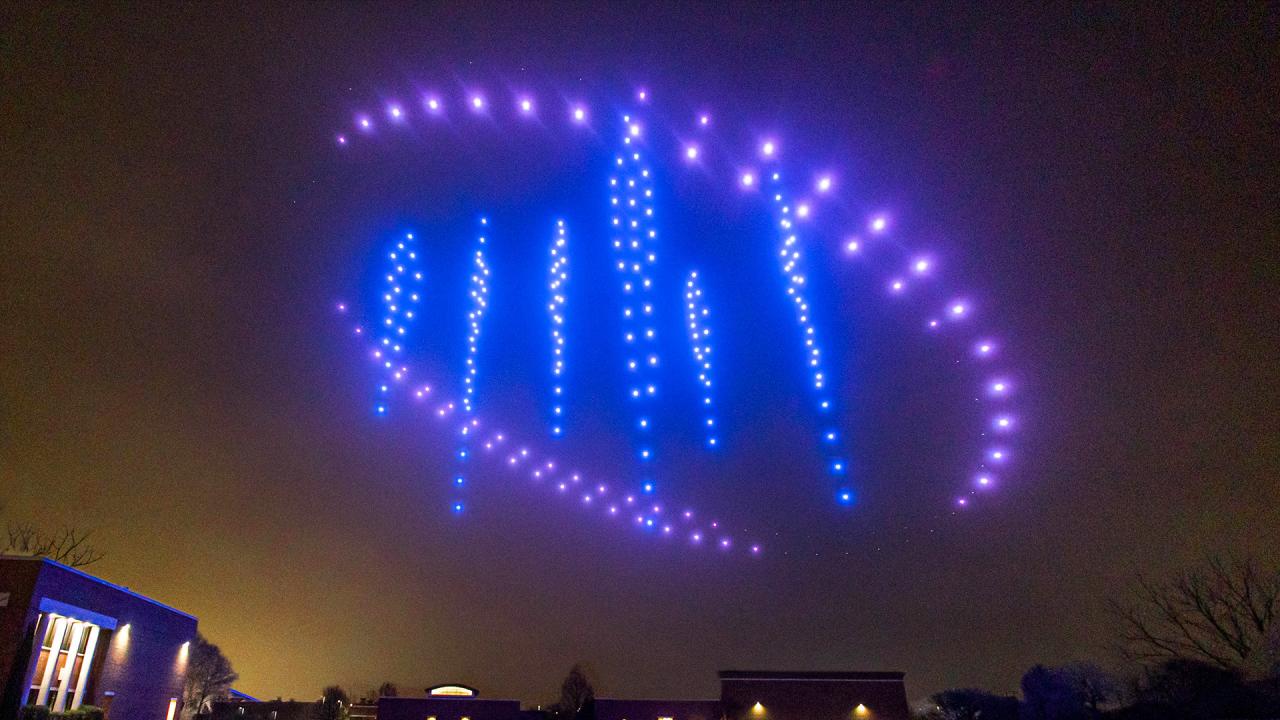How do drone shows work? This question unveils a fascinating world of technology, choreography, and spectacle. From the intricate flight patterns of hundreds of drones to the dazzling light displays they create, these aerial performances are a testament to engineering and artistry. We’ll explore the technology behind these shows, from the drones themselves to the software that orchestrates their movements, and delve into the planning, logistics, and regulations involved in putting on a successful drone show.
We’ll cover everything from the types of drones used and their capabilities, to the software that controls their movements and the intricate choreography involved in creating stunning visual displays. We’ll also discuss safety regulations, logistical considerations, and the exciting future of drone shows, including the potential for AI and autonomous flight to revolutionize the industry. Get ready for a behind-the-scenes look at this rapidly evolving and captivating form of entertainment!
So you wanna know how drone shows work? It’s all about precise programming and lots of tiny lights! Companies like jeju air might even use drones for advertising, showing how these programmed light displays can be used in creative ways. The key is coordinating the flight paths and lighting effects of hundreds, sometimes thousands, of drones to create a cohesive image or animation in the sky.
Drone Show Technology
Drone shows are a captivating spectacle of coordinated light and movement, but the technology behind them is surprisingly complex. It involves a sophisticated interplay of specialized drones, robust software, and precise control systems. Let’s delve into the technical aspects that make these shows possible.
Drone Types and Capabilities

Various drone models are employed in drone shows, each possessing unique capabilities tailored to specific show requirements. Generally, smaller, lightweight drones are preferred for their maneuverability and ease of control in large formations. Key features include GPS accuracy for precise positioning, powerful LEDs for vibrant light displays, and sufficient battery life to sustain the show’s duration. Larger drones might be used for carrying more substantial lighting systems or for specific visual effects.
Software and Hardware Components
A successful drone show relies on a robust interplay of software and hardware. The hardware encompasses the drones themselves, along with ground control stations (GCS) that manage and monitor the entire fleet. The software, often custom-built, is responsible for flight path planning, synchronization of drone movements, and real-time control of the lighting effects. This software usually interfaces with the GCS, enabling operators to oversee the entire show.
Drone Show Control Systems
Different control systems manage the complex coordination of drones in a show. These systems vary in their approach to communication, processing power, and scalability. Some systems rely on centralized control, where a single GCS manages all drones. Others employ a more distributed approach, with multiple GCSs coordinating subsets of drones. The choice of control system depends on the scale and complexity of the show.
Drone Specifications
| Drone Model | Flight Time (min) | Payload Capacity (g) | GPS Accuracy (m) |
|---|---|---|---|
| Example Drone A | 25 | 50 | 1 |
| Example Drone B | 30 | 75 | 0.5 |
| Example Drone C | 20 | 30 | 2 |
Flight Planning and Choreography
The mesmerizing patterns and formations in a drone show are the result of meticulous planning and choreography. This involves translating a creative vision into precise flight paths for each drone, ensuring perfect synchronization and stunning visual effects.
Drone Show Flight Path Planning
- Concept Development: Defining the overall theme, storyline, and desired visual effects.
- 3D Modeling and Simulation: Creating a virtual representation of the show’s choreography using specialized software.
- Flight Path Generation: Translating the 3D model into individual flight paths for each drone, accounting for factors such as speed, altitude, and spacing.
- Simulation and Refinement: Simulating the flight paths to identify and correct any potential collisions or issues.
- Upload and Testing: Uploading the finalized flight paths to the drones and conducting thorough on-site testing.
The Role of GPS and Navigation
Precise drone movements are enabled by sophisticated GPS and inertial measurement units (IMUs). GPS provides accurate positioning data, while IMUs measure the drone’s orientation and movement, enabling real-time adjustments and corrections to maintain the planned flight path. Redundant systems and fail-safes are crucial to ensure the safety and stability of the show.
Creating Synchronized Flight Patterns
Synchronization is achieved through precise timing and communication between the drones and the control system. Each drone receives its flight path instructions, and the control system ensures that all drones execute their movements in perfect harmony. Sophisticated algorithms and communication protocols are essential to maintaining this synchronization throughout the show.
Drone Show Choreography Workflow
A flowchart would visually represent the workflow, starting from the initial concept and progressing through design, simulation, testing, and final execution. Each stage would be a box in the flowchart, with arrows indicating the progression between stages. The flowchart would clearly depict the iterative nature of the process, with feedback loops for adjustments and refinements at each stage.
Lighting and Effects
The visual impact of a drone show is significantly influenced by the lighting effects employed. The choice of LEDs, lighting patterns, and creative techniques all contribute to the overall narrative and aesthetic appeal of the performance.
Lighting Effects and Implementation
A wide array of lighting effects are possible, including color changes, fades, strobing, and chasing effects. These effects are implemented through the software controlling the drones’ LEDs, allowing for dynamic and visually striking displays. Complex patterns and transitions can be programmed to create a sense of depth, movement, and narrative.
LED Types and Color Capabilities
High-brightness RGB LEDs are commonly used, offering a wide spectrum of colors and the ability to create smooth color gradients. The choice of LED depends on factors such as brightness, power consumption, and color accuracy. Higher-quality LEDs provide richer and more vibrant colors, enhancing the visual impact of the show.
Lighting Patterns and Visual Narrative
Different lighting patterns contribute to the overall storytelling and emotional impact of the show. For instance, bright, fast-paced patterns can create a sense of energy and excitement, while slower, more subdued patterns might evoke a feeling of calmness or tranquility. The strategic use of color also plays a crucial role in conveying specific moods and themes.
So, you wanna know how drone shows work? It’s all about precise programming of many drones to create illuminated patterns in the sky. A great example of this technology on a larger scale is seen with displays like those offered by companies specializing in drone fireworks china , which showcase the impressive capabilities of synchronized drone flight.
Basically, each drone acts as a pixel, and the combined effect is a breathtaking aerial light show. Understanding the programming behind this is key to grasping how these amazing displays are put together.
Creative Lighting Techniques
- Color-washing: Creating a uniform color across a large formation of drones.
- Pixel mapping: Utilizing individual LEDs to create complex images and animations.
- Dynamic transitions: Seamlessly shifting between different colors and patterns.
- Strobe effects: Creating flashing or pulsing light patterns.
- Chases: Moving patterns of light across the formation.
Safety and Regulations: How Do Drone Shows Work
Safety and regulatory compliance are paramount in drone show operations. Strict protocols, risk assessments, and adherence to legal frameworks are crucial to ensuring the safety of both the audience and the environment.
Safety Protocols and Risk Assessments
Thorough risk assessments are conducted to identify and mitigate potential hazards, including drone malfunctions, weather conditions, and airspace conflicts. Safety protocols encompass pre-flight checks, emergency procedures, and operator training. Redundancy in systems and communication is essential to ensure operational safety.
Permits and Licenses
Obtaining the necessary permits and licenses from aviation authorities and local governing bodies is crucial. These requirements vary depending on location, the size of the show, and the airspace involved. Failure to comply with regulations can result in legal repercussions and operational disruptions.
Role of Air Traffic Control
Air traffic control (ATC) plays a vital role in ensuring the safe integration of drone shows into the airspace. Coordination with ATC is necessary to avoid conflicts with other aircraft and to ensure the safety of the surrounding environment. Clear communication and adherence to ATC instructions are essential for a successful and safe drone show.
Emergency Procedures, How do drone shows work
Comprehensive emergency procedures must be in place to handle malfunctions or unexpected events. These procedures cover scenarios such as drone failures, loss of communication, or adverse weather conditions. A well-defined emergency response plan ensures a swift and effective response to minimize any potential risks.
Show Production and Logistics
Successful drone shows require meticulous planning and execution across various aspects of production and logistics. From site selection to team coordination, every detail contributes to the overall success of the event.
Location Selection
Selecting a suitable location involves considering factors such as airspace availability, audience visibility, and environmental conditions. The location should provide ample space for drone operations and offer a clear line of sight for the audience. Local regulations and airspace restrictions must also be carefully considered.
Logistical Considerations
Transporting, assembling, and deploying a large number of drones requires careful logistical planning. Secure transportation methods, efficient assembly procedures, and a well-organized deployment strategy are crucial to ensure the smooth execution of the show. Pre-show rehearsals and system checks are also vital to identify and address any potential issues.
Successful Drone Show Productions
Examples of successful drone shows can be found in various locations worldwide. These productions demonstrate the potential of drone technology to create awe-inspiring visual spectacles. Analysis of successful productions highlights the importance of creative choreography, advanced technology, and meticulous planning. Challenges such as weather conditions, technical malfunctions, and regulatory hurdles often need to be addressed to ensure a successful show.
Team Roles and Responsibilities

A successful drone show requires a well-coordinated team with clearly defined roles and responsibilities. This typically includes roles such as show director, drone pilots, technical engineers, and logistics managers. Effective communication and collaboration among team members are essential for seamless show execution.
The Future of Drone Shows

The future of drone shows promises even more spectacular displays and innovative applications. Emerging technologies and advancements in drone capabilities are poised to revolutionize the industry.
Emerging Technologies and Advancements
Artificial intelligence (AI) and autonomous flight systems are likely to play a significant role in the future of drone shows. AI can automate aspects of choreography, flight path planning, and even real-time adjustments based on environmental conditions. Advancements in drone capabilities, such as improved battery life, increased payload capacity, and more sophisticated lighting systems, will further enhance the visual spectacle.
Future Applications Beyond Entertainment
Beyond entertainment, drone shows hold potential for applications in advertising, public safety, and even artistic expression. Large-scale drone displays could be used to create dynamic advertisements in urban environments. Drones could also be used for search and rescue operations, providing aerial surveillance and assisting in emergency response. Artistic collaborations could leverage drone technology to create immersive and interactive art installations.
Drone shows use hundreds of drones, each with its own GPS and lights, to create dazzling aerial displays. The precision required is incredible; think of it like a massive, coordinated dance in the sky. News reports, like this one about a plane crash in South Korea , highlight how crucial precise control is in aerial operations. This same level of precision, but on a smaller and more artistic scale, is what makes drone shows so captivating.
Concept for a Futuristic Drone Show
A futuristic drone show might feature swarms of autonomous drones capable of forming complex, three-dimensional shapes and animations. These drones could incorporate advanced lighting systems, including lasers and holographic projectors, to create truly immersive and breathtaking displays. The show could be integrated with other technologies, such as augmented reality (AR), to enhance the audience experience.
Conclusive Thoughts
Drone shows are a captivating blend of technology and artistry, pushing the boundaries of what’s possible in aerial displays. From the initial concept and meticulous planning to the final breathtaking performance, each element plays a vital role in creating a truly unforgettable experience. As technology continues to advance, we can expect even more spectacular and innovative drone shows in the years to come, blurring the lines between entertainment, art, and technology.
FAQ Corner
How much do drone shows cost?
The cost varies greatly depending on the show’s scale, duration, complexity, and location. Expect to pay significantly more for larger, more elaborate shows.
How long does it take to plan a drone show?
Planning can take several weeks or even months, depending on the show’s complexity and the number of drones involved. This includes choreography, permitting, and logistical arrangements.
What happens if a drone malfunctions during a show?
Most drone shows have backup systems and protocols in place to handle malfunctions. Individual drones can often be safely landed or shut down remotely without impacting the rest of the show.
Are drone shows environmentally friendly?
Modern drones are relatively energy-efficient, but the environmental impact depends on factors like the number of drones, show duration, and transportation needs. Sustainable practices are increasingly important in the industry.
